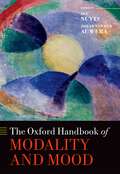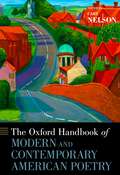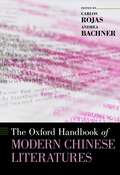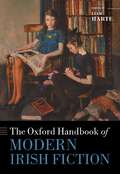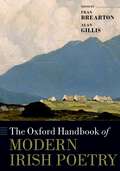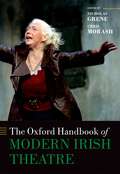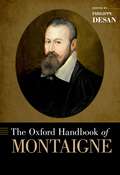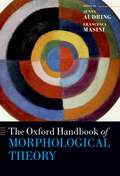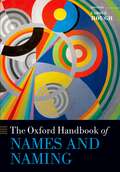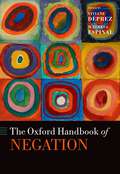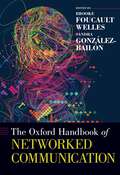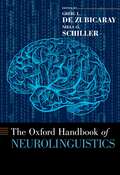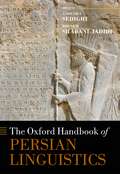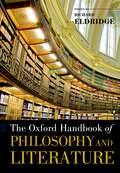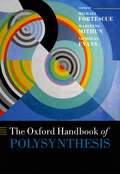- Table View
- List View
The Oxford Handbook of Modality and Mood (Oxford Handbooks)
This handbook offers an in depth and comprehensive state of the art survey of the linguistic domains of modality and mood. An international team of experts in the field examines the full range of methodological and theoretical approaches to the many facets of the phenomena involved. Parts 1 and 2 of the volume present the basic linguistic facts about the systems of modality and mood in the languages of the world, covering the semantics and the expression of different subtypes of modality and mood respectively. The authors also examine the interaction of modality and mood, mutually and with other semantic categories such as aspect, time, negation, and evidentiality. In Part 3, authors discuss the features of the modality and mood systems in five typologically different language groups, while chapters in Part 4 deal with wider perspectives on modality and mood: diachrony, areality, first language acquisition, and sign language. Finally, Part 5 looks at how modality and mood are handled in different theoretical approaches: formal syntax, functional linguistics, cognitive linguistics and construction grammar, and formal semantics.
The Oxford Handbook of Modern and Contemporary American Poetry (Oxford Handbooks)
The Oxford Handbook of Modern and Contemporary American Poetry gives readers a cutting-edge introduction to the kaleidoscopic world of American poetry over the last century. Offering a comprehensive approach to the debates that have defined the study of American verse, the twenty-five original essays contained herein take up a wide array of topics: the influence of jazz on the Beats and beyond; European and surrealist influences on style; poetics of the disenfranchised; religion and the national epic; antiwar and dissent poetry; the AIDS epidemic; digital innovations; transnationalism; hip hop; and more. Alongside these topics, major interpretive perspectives such as Marxist, psychoanalytic, disability, queer, and ecocritcal are incorporated. Throughout, the names that have shaped American poetry in the period--Ezra Pound, Wallace Stevens, Marianne Moore, Mina Loy, Sterling Brown, Hart Crane, William Carlos Williams, Posey, Langston Hughes, Allen Ginsberg, John Ashbery, Rae Armantrout, Larry Eigner, and others--serve as touchstones along the tour of the poetic landscape.
The Oxford Handbook of Modern Chinese Literatures (Oxford Handbooks)
by Carlos Rojas and Andrea BachnerWith over forty original essays, The Oxford Handbook of Modern Chinese Literatures offers an in-depth engagement with the current analytical methodologies and critical practices that are shaping the field in the twenty-first century. Divided into three sections--Structure, Taxonomy, and Methodology--the volume carefully moves across approaches, genres, and forms to address a rich range topics that include popular culture in Late Qing China, Zhang Guangyu's Journey to the West in Cartoons, writings of Southeast Asian migrants in Taiwan, the Chinese Anglophone Novel, and depictions of HIV/AIDS in Chu T'ien-wen's Notes of a Desolate Man.
The Oxford Handbook of Modern Chinese Literatures (Oxford Handbooks)
With over forty original essays, The Oxford Handbook of Modern Chinese Literatures offers an in-depth engagement with the current analytical methodologies and critical practices that are shaping the field in the twenty-first century. Divided into three sections--Structure, Taxonomy, and Methodology--the volume carefully moves across approaches, genres, and forms to address a rich range topics that include popular culture in Late Qing China, Zhang Guangyu's Journey to the West in Cartoons, writings of Southeast Asian migrants in Taiwan, the Chinese Anglophone Novel, and depictions of HIV/AIDS in Chu T'ien-wen's Notes of a Desolate Man.
The Oxford Handbook of Modern Irish Fiction (Oxford Handbooks)
by Liam HarteThe Oxford Handbook of Modern Irish Fiction presents authoritative essays by thirty-five leading scholars of Irish fiction. They provide in-depth assessments of the breadth and achievement of novelists and short story writers whose collective contribution to the evolution and modification of these unique art forms has been far out of proportion to Ireland's small size. The volume brings a variety of critical perspectives to bear on the development of modern Irish fiction, situating authors, texts, and genres in their social, intellectual, and literary historical contexts. The Handbook's coverage encompasses an expansive range of topics, including the recalcitrant atavisms of Irish Gothic fiction; nineteenth-century Irish women's fiction and its influence on emergent modernism and cultural nationalism; the diverse modes of irony, fabulism, and social realism that characterize the fiction of the Irish Literary Revival; the fearless aesthetic radicalism of James Joyce; the jolting narratological experiments of Samuel Beckett, Flann O'Brien, and Máirtín Ó Cadhain; the fate of the realist and modernist traditions in the work of Elizabeth Bowen, Frank O'Connor, Seán O'Faoláin, and Mary Lavin, and in that of their ambivalent heirs, Edna O'Brien, John McGahern, and John Banville; the subversive treatment of sexuality and gender in Northern Irish women's fiction written during and after the Troubles; the often neglected genres of Irish crime fiction, science fiction, and fiction for children; the many-hued novelistic responses to the experiences of famine, revolution, and emigration; and the variety and vibrancy of post-millennial fiction from both parts of Ireland. Readably written and employing a wealth of original research, The Oxford Handbook of Modern Irish Fiction illuminates a distinguished literary tradition that has altered the shape of world literature.
The Oxford Handbook of Modern Irish Fiction (Oxford Handbooks)
The Oxford Handbook of Modern Irish Fiction presents authoritative essays by thirty-five leading scholars of Irish fiction. They provide in-depth assessments of the breadth and achievement of novelists and short story writers whose collective contribution to the evolution and modification of these unique art forms has been far out of proportion to Ireland's small size. The volume brings a variety of critical perspectives to bear on the development of modern Irish fiction, situating authors, texts, and genres in their social, intellectual, and literary historical contexts. The Handbook's coverage encompasses an expansive range of topics, including the recalcitrant atavisms of Irish Gothic fiction; nineteenth-century Irish women's fiction and its influence on emergent modernism and cultural nationalism; the diverse modes of irony, fabulism, and social realism that characterize the fiction of the Irish Literary Revival; the fearless aesthetic radicalism of James Joyce; the jolting narratological experiments of Samuel Beckett, Flann O'Brien, and Máirtín Ó Cadhain; the fate of the realist and modernist traditions in the work of Elizabeth Bowen, Frank O'Connor, Seán O'Faoláin, and Mary Lavin, and in that of their ambivalent heirs, Edna O'Brien, John McGahern, and John Banville; the subversive treatment of sexuality and gender in Northern Irish women's fiction written during and after the Troubles; the often neglected genres of Irish crime fiction, science fiction, and fiction for children; the many-hued novelistic responses to the experiences of famine, revolution, and emigration; and the variety and vibrancy of post-millennial fiction from both parts of Ireland. Readably written and employing a wealth of original research, The Oxford Handbook of Modern Irish Fiction illuminates a distinguished literary tradition that has altered the shape of world literature.
The Oxford Handbook of Modern Irish Poetry (Oxford Handbooks)
Forty chapters, written by leading scholars across the world, describe the latest thinking on modern Irish poetry. The Handbook begins with a consideration of Yeats's early work, and the legacy of the 19th century. The broadly chronological areas which follow, covering the period from the 1910s through to the 21st century, allow scope for coverage of key poetic voices in Ireland in their historical and political context. From the experimentalism of Beckett, MacGreevy, and others of the modernist generation, to the refashioning of Yeats's Ireland on the part of poets such as MacNeice, Kavanagh, and Clarke mid-century, through to the controversially titled post-1969 'Northern Renaissance' of poetry, this volume will provide extensive coverage of the key movements of the modern period. The Handbook covers the work of, among others, Paul Durcan, Thomas Kinsella, Brendan Kennelly, Seamus Heaney, Paul Muldoon, Michael Longley, Medbh McGuckian, and Ciaran Carson. The thematic sections interspersed throughout - chapters on women's poetry, religion, translation, painting, music, stylistics - allow for comparative studies of poets north and south across the century. Central to the guiding spirit of this project is the Handbook's consideration of poetic forms, and a number of essays explore the generic diversity of poetry in Ireland, its various manipulations, reinventions and sometimes repudiations of traditional forms. The last essays in the book examine the work of a 'new' generation of poets from Ireland, concentrating on work published in the last two decades by Justin Quinn, Leontia Flynn, Sinead Morrissey, David Wheatley, Vona Groarke, and others.
The Oxford Handbook of Modern Irish Theatre (Oxford Handbooks)
by Nicholas Grene and Chris MorashThe Oxford Handbook of Modern Irish Theatre provides the single most comprehensive survey of the field to be found in a single volume. Drawing on more than forty contributors from around the world, the book addresses a full range of topics relating to modern Irish theatre from the late nineteenth-century to the most recent works of postdramatic devised theatre. Ireland has long had an importance in the world of theatre out of all proportion to the size of the country, and has been home to four Nobel Laureates (Yeats, Shaw, and Beckett; Seamus Heaney, while primarily a poet, also wrote for the stage). This collection begins with the influence of melodrama, and looks at arguably the first modern Irish playwright, Oscar Wilde, before moving into a series of considerations of the Abbey Theatre, and Irish modernism. Arranged chronologically, it explores areas such as women in theatre, Irish-language theatre, and alternative theatres, before reaching the major writers of more recent Irish theatre, including Brian Friel and Tom Murphy, and their successors. There are also individual chapters focusing on Beckett and Shaw, as well as a series of chapters looking at design, acting, and theatre architecture. The book concludes with an extended survey of the critical literature on the field. In each chapter, the author does not simply rehearse accepted wisdom; all of the contributors push the boundaries of their respective fields, so that each chapter is a significant contribution to scholarship in its own right.
The Oxford Handbook of Montaigne (Oxford Handbooks)
by Philippe DesanIn 1580, Michel de Montaigne (1533-1592) published a book unique by its title and its content: Essays"R. A literary genre was born. At first sight, the Essays resemble a patchwork of personal reflections, but they engage with questions that animate the human mind, and tend toward a single goal: to live better in the present and to prepare for death. For this reason, Montaigne's thought and writings have been a subject of enduring interest across disciplines. This Handbook brings together essays by prominent scholars that examine Montaigne's literary, philosophical, and political contributions, and assess his legacy and relevance today in a global perspective. The chapters of this Handbook offer a sweeping study of Montaigne across different disciplines and in a global perspective. One section covers the historical Montaigne, situating his thought in his own time and space, notably the Wars of Religion in France. The political, historical and religious context of Montaigne's Essays requires a rigorous presentation to inform the modern reader of the issues and problems that confronted Montaigne and his contemporaries in his own time. In addition to this contextual approach to Montaigne, the Handbook also establishes a connection between Montaigne's writings and issues and problems directly relevant to our modern times, that is to say, our age of global ideology. Montaigne's considerations, or essays, offer a point of departure for the modern reader's own assessments. The Essays analyze what can be broadly defined as human nature, the endless process by which the individual tries to impose opinions upon others through the production of laws, policies or philosophies. Montaigne's motto -- "What do I know?" -- is a simple question yet one of perennial significance. One could argue that reading Montaigne today teaches us that the angle defines the world we see, or, as Montaigne wrote: "What matters is not merely that we see the thing, but how we see it."
The Oxford Handbook of Montaigne (Oxford Handbooks)
In 1580, Michel de Montaigne (1533-1592) published a book unique by its title and its content: Essays"R. A literary genre was born. At first sight, the Essays resemble a patchwork of personal reflections, but they engage with questions that animate the human mind, and tend toward a single goal: to live better in the present and to prepare for death. For this reason, Montaigne's thought and writings have been a subject of enduring interest across disciplines. This Handbook brings together essays by prominent scholars that examine Montaigne's literary, philosophical, and political contributions, and assess his legacy and relevance today in a global perspective. The chapters of this Handbook offer a sweeping study of Montaigne across different disciplines and in a global perspective. One section covers the historical Montaigne, situating his thought in his own time and space, notably the Wars of Religion in France. The political, historical and religious context of Montaigne's Essays requires a rigorous presentation to inform the modern reader of the issues and problems that confronted Montaigne and his contemporaries in his own time. In addition to this contextual approach to Montaigne, the Handbook also establishes a connection between Montaigne's writings and issues and problems directly relevant to our modern times, that is to say, our age of global ideology. Montaigne's considerations, or essays, offer a point of departure for the modern reader's own assessments. The Essays analyze what can be broadly defined as human nature, the endless process by which the individual tries to impose opinions upon others through the production of laws, policies or philosophies. Montaigne's motto -- "What do I know?" -- is a simple question yet one of perennial significance. One could argue that reading Montaigne today teaches us that the angle defines the world we see, or, as Montaigne wrote: "What matters is not merely that we see the thing, but how we see it."
The Oxford Handbook of Morphological Theory (Oxford Handbooks)
by Jenny Audring Francesca MasiniThis volume is the first handbook devoted entirely to the multitude of frameworks adopted in the field of morphology, including Minimalism, Optimality Theory, Network Morphology, Cognitive Grammar, and Canonical Typology. Following an introduction from the editors, the first part of the volume offers critical discussions of the main theoretical issues within morphology, both in word formation and in inflection, as well as providing a short history of morphological theory. In the core part of the handbook, part II, each theory is introduced by an expert in the field, who guides the reader through its principles and technicalities, its advantages and disadvantages, and its points of agreement and disagreement with alternative theories. Chapters in part III explore the bigger picture, connecting morphological theory to other subdisciplines of linguistics, such as diachronic change, language acquisition, psycholinguistics, and sign language theory. The handbook is intended as a guide for morphologists from all theoretical backgrounds who want to learn more about frameworks other than their own, as well as for linguists in related subfields looking for theoretical connections with the field of morphology.
The Oxford Handbook of Morphological Theory
This volume is the first handbook devoted entirely to the multitude of frameworks adopted in the field of morphology, including Minimalism, Optimality Theory, Network Morphology, Cognitive Grammar, and Canonical Typology. Following an introduction from the editors, the first part of the volume offers critical discussions of the main theoretical issues within morphology, both in word formation and in inflection, as well as providing a short history of morphological theory. In the core part of the handbook, part II, each theory is introduced by an expert in the field, who guides the reader through its principles and technicalities, its advantages and disadvantages, and its points of agreement and disagreement with alternative theories. Chapters in part III explore the bigger picture, connecting morphological theory to other subdisciplines of linguistics, such as diachronic change, language acquisition, psycholinguistics, and sign language theory. The handbook is intended as a guide for morphologists from all theoretical backgrounds who want to learn more about frameworks other than their own, as well as for linguists in related subfields looking for theoretical connections with the field of morphology.
The Oxford Handbook of Names and Naming (Oxford Handbooks)
by Carole Hough and Daria IzdebskaIn this handbook, scholars from around the world offer an up-to-date account of the state of the art in different areas of onomastics, in a format that is both useful to specialists in related fields and accessible to the general reader. Since Ancient Greece, names have been regarded as central to the study of language, and this has continued to be a major theme of both philosophical and linguistic enquiry throughout the history of Western thought. The investigation of name origins is more recent, as is the study of names in literature. Relatively new is the study of names in society, which draws on techniques from sociolinguistics and has gradually been gathering momentum over the last few decades. The structure of this volume reflects the emergence of the main branches of name studies, in roughly chronological order. The first Part focuses on name theory and outlines key issues about the role of names in language, focusing on grammar, meaning, and discourse. Parts II and III deal with the study of place-names and personal names respectively, while Part IV outlines contrasting approaches to the study of names in literature, with case studies from different languages and time periods. Part V explores the field of socio-onomastics, with chapters relating to the names of people, places, and commercial products. Part VI then examines the interdisciplinary nature of name studies, before the concluding Part presents a selection of animate and inanimate referents ranging from aircraft to animals, and explains the naming strategies adopted for them.
The Oxford Handbook of Names and Naming (Oxford Handbooks)
In this handbook, scholars from around the world offer an up-to-date account of the state of the art in different areas of onomastics, in a format that is both useful to specialists in related fields and accessible to the general reader. Since Ancient Greece, names have been regarded as central to the study of language, and this has continued to be a major theme of both philosophical and linguistic enquiry throughout the history of Western thought. The investigation of name origins is more recent, as is the study of names in literature. Relatively new is the study of names in society, which draws on techniques from sociolinguistics and has gradually been gathering momentum over the last few decades. The structure of this volume reflects the emergence of the main branches of name studies, in roughly chronological order. The first Part focuses on name theory and outlines key issues about the role of names in language, focusing on grammar, meaning, and discourse. Parts II and III deal with the study of place-names and personal names respectively, while Part IV outlines contrasting approaches to the study of names in literature, with case studies from different languages and time periods. Part V explores the field of socio-onomastics, with chapters relating to the names of people, places, and commercial products. Part VI then examines the interdisciplinary nature of name studies, before the concluding Part presents a selection of animate and inanimate referents ranging from aircraft to animals, and explains the naming strategies adopted for them.
The Oxford Handbook of Negation (Oxford Handbooks)
by Viviane Déprez M. Teresa EspinalIn this volume, international experts in negation provide a comprehensive overview of cross-linguistic and philosophical research in the field, as well as accounts of more recent results from experimental linguistics, psycholinguistics, and neuroscience. The volume adopts an interdisciplinary approach to a range of fundamental questions ranging from why negation displays so many distinct linguistic forms to how prosody and gesture participate in the interpretation of negative utterances. Following an introduction from the editors, the chapters are arranged in eight parts that explore, respectively, the fundamentals of negation; issues in syntax; the syntax-semantics interface; semantics and pragmatics; negative dependencies; synchronic and diachronic variation; the emergence and acquisition of negation; and experimental investigations of negation. The volume will be an essential reference for students and researchers across a wide range of disciplines, and will facilitate further interdisciplinary work in the field.
The Oxford Handbook of Negation (Oxford Handbooks)
In this volume, international experts in negation provide a comprehensive overview of cross-linguistic and philosophical research in the field, as well as accounts of more recent results from experimental linguistics, psycholinguistics, and neuroscience. The volume adopts an interdisciplinary approach to a range of fundamental questions ranging from why negation displays so many distinct linguistic forms to how prosody and gesture participate in the interpretation of negative utterances. Following an introduction from the editors, the chapters are arranged in eight parts that explore, respectively, the fundamentals of negation; issues in syntax; the syntax-semantics interface; semantics and pragmatics; negative dependencies; synchronic and diachronic variation; the emergence and acquisition of negation; and experimental investigations of negation. The volume will be an essential reference for students and researchers across a wide range of disciplines, and will facilitate further interdisciplinary work in the field.
The Oxford Handbook of Networked Communication (Oxford Handbooks)
by Brooke Foucault Welles Sandra González-BailónCommunication technologies, including the internet, social media, and countless online applications create the infrastructure and interface through which many of our interactions take place today. This form of networked communication creates new questions about how we establish relationships, engage in public, build a sense of identity, and delimit the private domain. The ubiquitous adoption of new technologies has also produced, as a byproduct, new ways of observing the world: many of our interactions now leave a digital trail that, if followed, can help us unravel the rhythms of social life and the complexity of the world we inhabit--and thus help us reconstruct the logic of social order and change. The analysis of digital data requires partnerships across disciplinary boundaries that--although on the rise--are still uncommon. Social scientists and computer scientists have never been closer in their goals of trying to understand communication dynamics, but there are not many venues where they can engage in an open exchange of methods and theoretical insights. This handbook brings together scholars across the social and technological sciences to lay the foundations of communication research in the networked age, and to provide a canon of how research should be conducted in the digital era. The contributors highlight the main theories currently guiding their research in digital communication, and discuss state-of-the-art methodological tools, including automated text analysis, the analysis of networks, and the use of natural experiments in virtual environments. Following a general introduction, the handbook covers network and information flow, communication and organizational dynamics, interactions and social capital, mobility and space, political communication and behavior, and the ethics of digital research.
The Oxford Handbook of Networked Communication (Oxford Handbooks)
Communication technologies, including the internet, social media, and countless online applications create the infrastructure and interface through which many of our interactions take place today. This form of networked communication creates new questions about how we establish relationships, engage in public, build a sense of identity, and delimit the private domain. The ubiquitous adoption of new technologies has also produced, as a byproduct, new ways of observing the world: many of our interactions now leave a digital trail that, if followed, can help us unravel the rhythms of social life and the complexity of the world we inhabit--and thus help us reconstruct the logic of social order and change. The analysis of digital data requires partnerships across disciplinary boundaries that--although on the rise--are still uncommon. Social scientists and computer scientists have never been closer in their goals of trying to understand communication dynamics, but there are not many venues where they can engage in an open exchange of methods and theoretical insights. This handbook brings together scholars across the social and technological sciences to lay the foundations of communication research in the networked age, and to provide a canon of how research should be conducted in the digital era. The contributors highlight the main theories currently guiding their research in digital communication, and discuss state-of-the-art methodological tools, including automated text analysis, the analysis of networks, and the use of natural experiments in virtual environments. Following a general introduction, the handbook covers network and information flow, communication and organizational dynamics, interactions and social capital, mobility and space, political communication and behavior, and the ethics of digital research.
The Oxford Handbook of Neurolinguistics (Oxford Handbooks)
by GREIG I. DE ZUBICARAY Niels O. SchillerNeurolinguistics is a young and highly interdisciplinary field, with influences from psycholinguistics, psychology, aphasiology, and (cognitive) neuroscience, as well as other fields. Neurolinguistics, like psycholinguistics, covers aspects of language processing; but unlike psycholinguistics, it draws on data from patients with damage to language processing capacities, or the use of modern neuroimaging technologies such as fMRI, TMS, or both. The burgeoning interest in neurolinguistics reflects that an understanding of the neural bases of this data can inform more biologically plausible models of the human capacity for language. The Oxford Handbook of Neurolinguistics provides concise overviews of this rapidly-growing field, and engages a broad audience with an interest in the neurobiology of language. The chapters do not attempt to provide exhaustive coverage, but rather present discussions of prominent questions posed by given topics. The volume opens with essential methodological chapters: Section I, Methods, covers the key techniques and technologies used to study the neurobiology of language today, with chapters structured along the basic divisions of the field. Section II addresses the neurobiology of language acquisition during healthy development and in response to challenges presented by congenital and acquired conditions. Section III covers the many facets of our articulate brain, or speech-language pathology, and the capacity for language production-written, spoken, and signed. Questions regarding how the brain comprehends meaning, including emotions at word and discourse levels, are addressed in Section IV. Finally, Section V reaches into broader territory, characterizing and contextualizing the neurobiology of language with respect to more fundamental neuroanatomical mechanisms and general cognitive domains.
The Oxford Handbook of Neurolinguistics (Oxford Handbooks)
Neurolinguistics is a young and highly interdisciplinary field, with influences from psycholinguistics, psychology, aphasiology, and (cognitive) neuroscience, as well as other fields. Neurolinguistics, like psycholinguistics, covers aspects of language processing; but unlike psycholinguistics, it draws on data from patients with damage to language processing capacities, or the use of modern neuroimaging technologies such as fMRI, TMS, or both. The burgeoning interest in neurolinguistics reflects that an understanding of the neural bases of this data can inform more biologically plausible models of the human capacity for language. The Oxford Handbook of Neurolinguistics provides concise overviews of this rapidly-growing field, and engages a broad audience with an interest in the neurobiology of language. The chapters do not attempt to provide exhaustive coverage, but rather present discussions of prominent questions posed by given topics. The volume opens with essential methodological chapters: Section I, Methods, covers the key techniques and technologies used to study the neurobiology of language today, with chapters structured along the basic divisions of the field. Section II addresses the neurobiology of language acquisition during healthy development and in response to challenges presented by congenital and acquired conditions. Section III covers the many facets of our articulate brain, or speech-language pathology, and the capacity for language production-written, spoken, and signed. Questions regarding how the brain comprehends meaning, including emotions at word and discourse levels, are addressed in Section IV. Finally, Section V reaches into broader territory, characterizing and contextualizing the neurobiology of language with respect to more fundamental neuroanatomical mechanisms and general cognitive domains.
The Oxford Handbook of Persian Linguistics (Oxford Handbooks)
by Pouneh Shabani-Jadidi Anousha SedighiThis handbook offers a comprehensive overview of the field of Persian linguistics, discusses its development, and captures critical accounts of cutting edge research within its major subfields, as well as outlining current debates and suggesting productive lines of future research. Leading scholars in the major subfields of Persian linguistics examine a range of topics split into six thematic parts. Following a detailed introduction from the editors, the volume begins by placing Persian in its historical and typological context in Part I. Chapters in Part II examine topics relating to phonetics and phonology, while Part III looks at approaches to and features of Persian syntax. The fourth part of the volume explores morphology and lexicography, as well as the work of the Academy of Persian Language and Literature. Part V, language and people, covers topics such as language contact and teaching Persian as a foreign language, while the final part examines psycho- neuro-, and computational linguistics. The volume will be an essential resource for all scholars with an interest in Persian language and linguistics.
The Oxford Handbook of Persian Linguistics (Oxford Handbooks)
This handbook offers a comprehensive overview of the field of Persian linguistics, discusses its development, and captures critical accounts of cutting edge research within its major subfields, as well as outlining current debates and suggesting productive lines of future research. Leading scholars in the major subfields of Persian linguistics examine a range of topics split into six thematic parts. Following a detailed introduction from the editors, the volume begins by placing Persian in its historical and typological context in Part I. Chapters in Part II examine topics relating to phonetics and phonology, while Part III looks at approaches to and features of Persian syntax. The fourth part of the volume explores morphology and lexicography, as well as the work of the Academy of Persian Language and Literature. Part V, language and people, covers topics such as language contact and teaching Persian as a foreign language, while the final part examines psycho- neuro-, and computational linguistics. The volume will be an essential resource for all scholars with an interest in Persian language and linguistics.
The Oxford Handbook of Philosophy and Literature (Oxford Handbooks)
The Oxford Handbook of Philosophy and Literature contains twenty-three newly commissioned essays by major philosophers and literary scholars that investigate literature as a form of attention to human life. Various forms of attention are considered under the headings of Genres (from Ancient Epic to the Novel and Contemporary Experimental Writing), Periods (from Realism and Romanticism to Postcolonialism), Devices and Powers (Imagination, Plot, Character, Style, and Emotion), and Contexts and Uses (in relation to inquiry, morality, and politics). In each case, the effort is to track and evaluate how specific modes and works of imaginative literature answer to important needs of human subjects for orientation, the articulation of interest in life, and the working through of emotion, within situations that are both sociohistorical and human. Hence these essays show how and why literature matters in manifold ways in and for human cultural life, and they show how philosophers and imaginative literary writers have continually both engaged with and criticized each other.
The Oxford Handbook of Polysynthesis (Oxford Handbooks)
by Nicholas Evans Marianne Mithun Michael FortescueThis handbook offers an extensive crosslinguistic and cross-theoretical survey of polysynthetic languages, in which single multi-morpheme verb forms can express what would be whole sentences in English. These languages and the problems they raise for linguistic analyses have long featured prominently in language descriptions, and yet the essence of polysynthesis remains under discussion, right down to whether it delineates a distinct, coherent type, rather than an assortment of frequently co-occurring traits. Chapters in the first part of the handbook relate polysynthesis to other issues central to linguistics, such as complexity, the definition of the word, the nature of the lexicon, idiomaticity, and to typological features such as argument structure and head marking. Part two contains areal studies of those geographical regions of the world where polysynthesis is particularly common, such as the Arctic and Sub-Arctic and northern Australia. The third part examines diachronic topics such as language contact and language obsolence, while part four looks at acquisition issues in different polysynthetic languages. Finally, part five contains detailed grammatical descriptions of over twenty languages which have been characterized as polysynthetic, with special attention given to the presence or absence of potentially criterial features.
The Oxford Handbook of Polysynthesis (Oxford Handbooks)
This handbook offers an extensive crosslinguistic and cross-theoretical survey of polysynthetic languages, in which single multi-morpheme verb forms can express what would be whole sentences in English. These languages and the problems they raise for linguistic analyses have long featured prominently in language descriptions, and yet the essence of polysynthesis remains under discussion, right down to whether it delineates a distinct, coherent type, rather than an assortment of frequently co-occurring traits. Chapters in the first part of the handbook relate polysynthesis to other issues central to linguistics, such as complexity, the definition of the word, the nature of the lexicon, idiomaticity, and to typological features such as argument structure and head marking. Part two contains areal studies of those geographical regions of the world where polysynthesis is particularly common, such as the Arctic and Sub-Arctic and northern Australia. The third part examines diachronic topics such as language contact and language obsolence, while part four looks at acquisition issues in different polysynthetic languages. Finally, part five contains detailed grammatical descriptions of over twenty languages which have been characterized as polysynthetic, with special attention given to the presence or absence of potentially criterial features.
